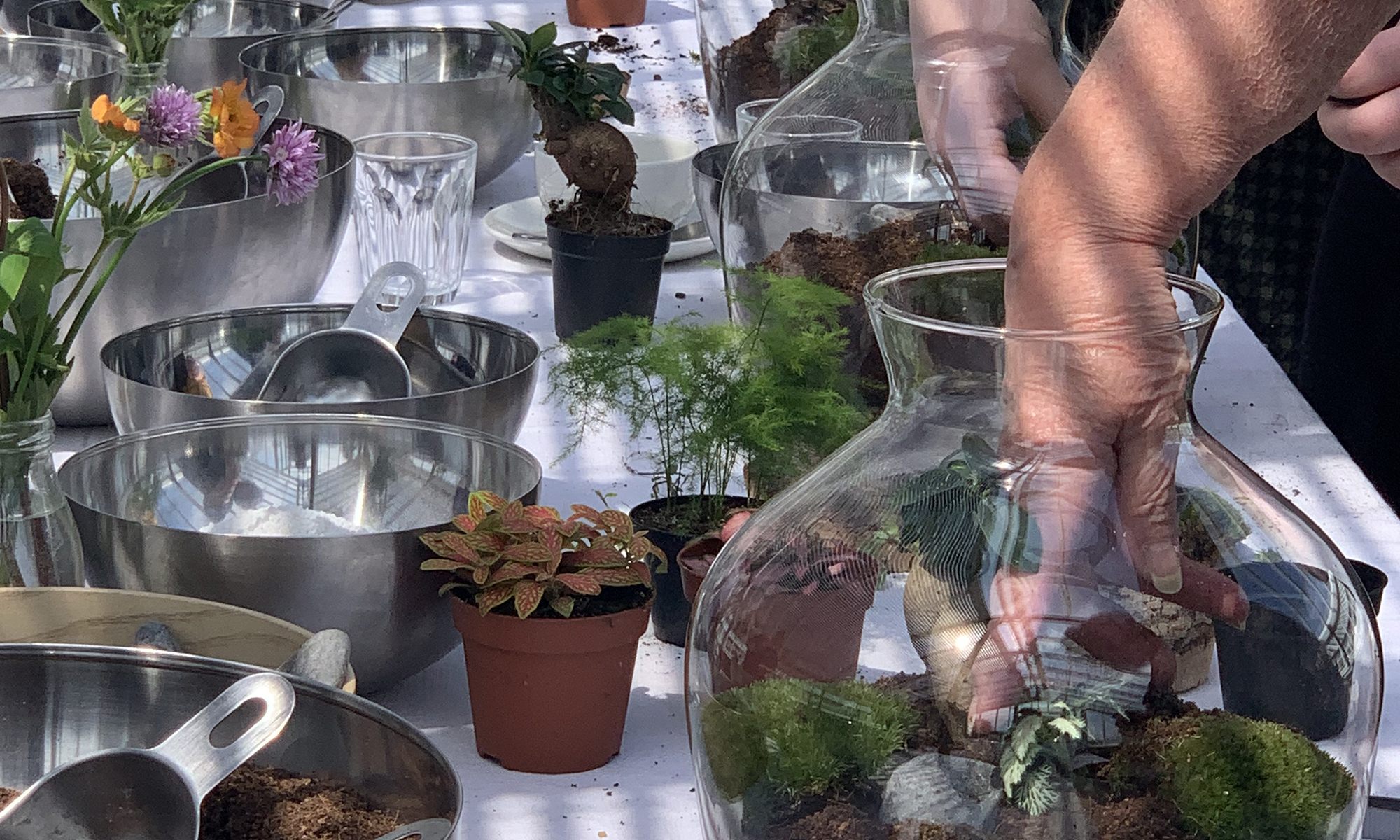Jo Arnell finds out that there’s so much more to terrariums than first meets the eye when she meets Sebastian Tribe, founder of Terrapy
Making a self-sustaining botanical world filled with beautiful, miniature plants is – if Sebastian Tribe has anything to do with it – a serene, creative and satisfying activity. The calmest form of world building – no volcanoes, storms or invasions will disrupt the landscape (unless you drop it), the mountains are scalable, and you are the custodian of your own little jungle.
Seb, a lawyer, rather than a botanist by profession, originally worked in the city, “I enjoyed my time there, but escaped into another world.” He is now the owner of Terrapy, his terrarium business. Once you dive into this seemingly tiny domain, there is another far larger one waiting to be explored, and fascinating it is too, brimming with history, science and intrigue. I talk to Seb about the evolution of the terrarium and how the therapeutic benefits of owning, making and maintaining them has inspired him to run workshops and produce beautiful and environmentally friendly mini ecosystems.
Terrariums as we know them today have evolved from the Wardian case. This portable mini greenhouse was invented in 1830 by Nathanial Ward, a doctor with an interest in entomology and – like many Victorians – ferns. He noticed that his ferns were thriving in the glass cases he kept his specimens in – and so, almost by accident, invented a system for transporting plants across the world, that had hitherto perished on long sea journeys. It meant that the intrepid plant hunters of this era were now able to bring back rare and exotic species that nurseries could propagate and sell. It also meant that living plants could become commodities.
Tea was one such highly prized and carefully guarded product, produced and monopolised where the tea plant Camellia sinensis grew in China. That monopoly was ended thanks in part to the smuggling of tea plants from China to India by botanist Robert Fortune, who managed to pack Wardian cases with seedlings and successfully ship them from Shanghai to India – changing the course of history in the process.
Back in England during the craze for ferns that came to be known as pteridomania, Wardian cases were used to protect delicate specimens from the smoggy, sooty air that filled the towns and cities, and provided a miniature escape into a clean and leafy world. Fern collectors were often young women, and for them the escape was a big one. In an age where women had little agency, fern collecting was deemed a wholesome and educational activity. Many women were allowed out unchaperoned to go fern hunting and experience a liberating taste of freedom and autonomy.
It is amazing to think that a small glass container can do such mighty work – and Seb is determined that Terrapy does its fair share: “I want Terrapy to work in the interest of society,” he says. “Wardian cases have unlocked progress. Today, they can also help us to expand access to horticulture. Part of our mission is to make this form of gardening possible for those who don’t have their own land to cultivate, perhaps living as many of us do in flats or shared housing.” Terrapy runs a scheme providing free workshops to registered charities that support those who don’t have the ability or means to access horticulture. They have also committed to donating 10% of their annual profits to organisations mitigating climate breakdown and fighting for social equity.
Caring for the environment is a large part of what the company stands for. “We are currently building our first workshop almost entirely from construction waste and already have a very low carbon footprint. Constant changes are being made to our terrariums as we race towards zero, but while a gap remains we fund a non-profit, that permanently stops dangerous greenhouse gases leaking from dumped fridges into the atmosphere, to counteract our small impact many times over. We use recycled or reclaimed materials in our terrariums wherever feasible, and avoid single use materials,” Seb says.
They hope to eventually reach their goal of being carbon negative, and maintain their prestigious ESGmark® certification – which recognises businesses that achieve ‘a high level of performance against Environmental, Social and Governance (ESG) principles and an ongoing commitment to positive change’.
In all living worlds, no matter how small, there will be dynamic forces at work. The scene within the terrarium will alter as time allows its endless cycle of growth, decay and renewal, especially if you keep the lid on. In fact if the container is sealed it will be self-sustaining, needing only sunlight to allow life to continue in its many forms. “Most of the plants are tropical,” says Seb, “and so they thrive in this enclosed, humid environment. When I teach, I talk about two directions to take – you can allow the plants to compete, or you can intervene and curate the beauty. I made one for my grandmother which had a Ficus Ginseng in the middle, a Peperomia, a Begonia, Tradescantia and some moss and ferns. Six months later it had transformed from pristine into a jumble and some of the plants had completely disappeared! It’s a closed ecosystem and you can see how delicate some plants are, how we can affect them and how things can change.” This reminds me of a man I’d heard about who kept a sealed terrarium alive for decades. “Ah, that’s David Latimer,” Seb replies. “He made the longest lasting terrarium on record in 1960 and sealed it up after its final watering in 1972. It’s in a stoppered bottle called a carboy.”
Is creating a terrarium the ultimate low maintenance way to grow houseplants? As a notorious houseplant murderer, I’m pleased to hear that this is exactly how tropical plants would choose to grow. Seb is quick to reassure me that the massacres might not be all my fault. “I ask people for a show of hands at the workshops – ‘Who has killed a houseplant?’ People feel like they’re doing something wrong, but these are rainforest plants and houses are often too dry, so we have to intervene with regular watering and misting to remedy the difference from their natural environment. We call them houseplants, but to me that’s an example of how language gets inaccurately used.”
So, how to make a terrarium? Well the good news is that Seb maintains that it’s not too difficult. “You can salvage everything you need to make a terrarium except for the soil – you need a light, fluffy mix that emulates the rainforest floor. We use organic coco coir as the base, which is waste from an organic farm, and the only thing we source from outside Europe to help us remain peat free. We find that volcanic rock and moss are both great for holding moisture. We use a cleaner form of rock that naturally forms into small pieces, meaning it doesn’t need to be pulverised, and the moss in our soil is actually waste from another process! The plant nutrition comes from a vermicast (worm cast) mix, but we don’t use garden compost because this will mould over and break down too quickly.” Pre-made terrarium soil is available to buy from many independent garden centres and plant shops.
As for the plants to choose, that’s up to personal preference, although there are some that work particularly well. Asparagus ferns look remarkably like little trees, as do small Ficus microcarpa Ginseng. “Fittonia go well with varieties of Peperomia, some types of Ficus, certain ferns. You can create the illusion of a small forest. Peperomia is popular because there are so many colourful varieties and they are generally quite tolerant and resilient. You can even use rooted cuttings from your own tropical plants at home, I have made many terrariums without needing to buy any plants.”
Terrapy’s public workshops take place at several independent venues across the South East and are a wonderful escape from the stresses of day-to-day life. It is lovely to learn and connect with the living world in such a unique and intriguing way. “It’s great when, say, a group of nurses come in after a shift for an evening workshop,” says Seb. “Even though they might have been stressed and tired, silence falls for a few moments and they become totally absorbed in their tiny gardens.”
Many of Seb’s private workshops take place in corporate settings where his previous career started in London. “Particularly in the city a lot of time is sacrificed on the altar of mindfulness. Mindful meditation is something I really recommend people try, but some find it very challenging. For many, the mere idea of stopping can lead to confrontation with uncomfortable thoughts and feelings, so we need to find other ways to access that same headspace. Our workshops offer an opportunity to discover their creative space and a creative outlet.”
Most medicine is derived from plants, at Terrapy the plants are the medicine – supplied in a bottle.
Find out more about terrariums, their intriguing history, how to make one, and where to book a workshop at terrapy.uk
You may also like
In the Night Garden
Jo Arnell explains how to make the most of your outdoor space once darkness falls Some enchanted evening you may see me outside – mainly searching for slugs in the garden, because the cool hours of night are when they...
Contain your excitement
Jen Stuart-Smith discusses how to get creative with your pots and planters My love affair with plants started with houseplants when I was a child. As my bedroom windowsill overflowed – resulting, occasionally, in waking up with compost under my...
More than just a pretty face
Jen Stuart-Smith explores the multiple uses of some easy-to-grow garden favourites When you grow flowers for their beauty, shape and colour it can be easy to forget all the other qualities they have to offer. Some are edible, others provide...










